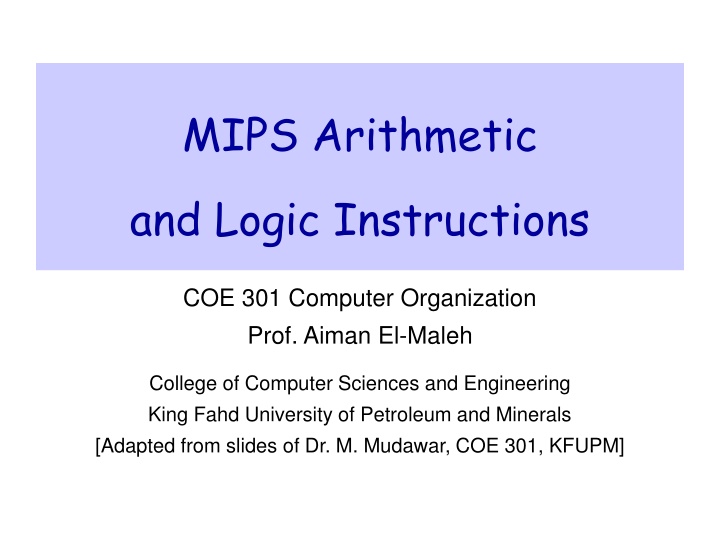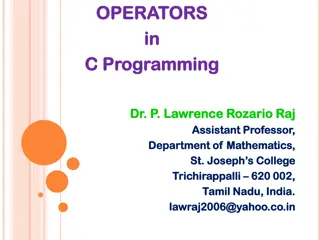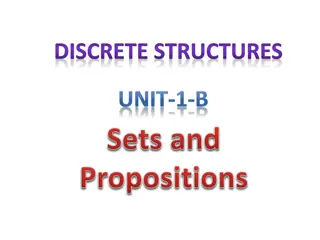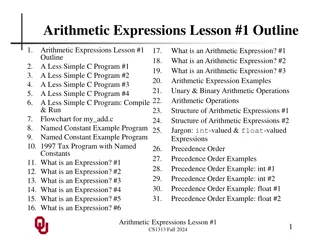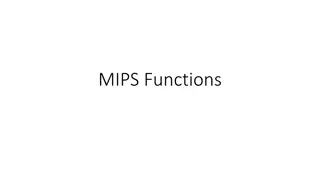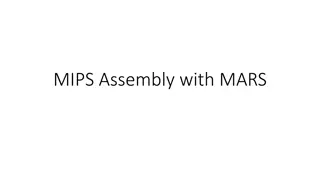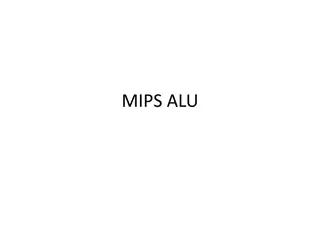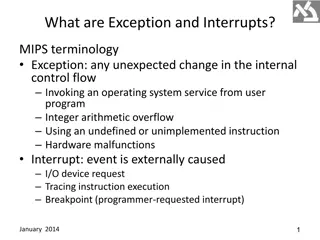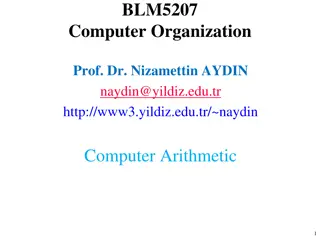Overview of MIPS Arithmetic and Logic Instructions in COE 301
MIPS Architecture consists of R-Type and I-Type instruction formats for arithmetic, logical, shift, and immediate constant operations. It includes a variety of general-purpose registers and specific units for execution, floating-point operations, and memory handling. The presentation outlines the structure of MIPS architecture, highlighting the key components such as General Purpose Registers, Arithmetic & Logic Unit, and Floating-Point Unit. It covers various instruction categories including Integer Arithmetic, Data Transfer, Jump and Branch, Floating-Point Arithmetic, and more. Software defines names for registers to standardize usage in the MIPS 32-bit architecture.
Download Presentation

Please find below an Image/Link to download the presentation.
The content on the website is provided AS IS for your information and personal use only. It may not be sold, licensed, or shared on other websites without obtaining consent from the author.If you encounter any issues during the download, it is possible that the publisher has removed the file from their server.
You are allowed to download the files provided on this website for personal or commercial use, subject to the condition that they are used lawfully. All files are the property of their respective owners.
The content on the website is provided AS IS for your information and personal use only. It may not be sold, licensed, or shared on other websites without obtaining consent from the author.
E N D
Presentation Transcript
MIPS Arithmetic and Logic Instructions COE 301 Computer Organization Prof. Aiman El-Maleh College of Computer Sciences and Engineering King Fahd University of Petroleum and Minerals [Adapted from slides of Dr. M. Mudawar, COE 301, KFUPM]
Presentation Outline Overview of the MIPS Architecture R-Type Instruction Format R-type Arithmetic, Logical, and Shift Instructions I-Type Instruction Format and Immediate Constants I-type Arithmetic and Logical Instructions Pseudo Instructions Multiplication and Division Instructions MIPS Arithmetic and Logic Instructions COE 301 KFUPM slide 2
Overview of the MIPS Architecture . . . Memory 4 bytes per word Up to 232 bytes = 230 words . . . EIU FPU Execution & Integer Unit (Main proc) Floating Point Unit (Coproc 1) $0 $1 $2 F0 F1 F2 32 General Purpose Registers 32 Floating-Point Registers $31 F31 Arithmetic & Logic Unit Integer mul/div FP Arith ALU Floating-Point Arithmetic Unit Hi Lo TMU Trap & Memory Unit (Coproc 0) BadVaddr Status Cause Integer EPC Multiplier/Divider MIPS Arithmetic and Logic Instructions COE 301 KFUPM slide 3
MIPS General-Purpose Registers 32 General Purpose Registers (GPRs) All registers are 32-bit wide in the MIPS 32-bit architecture Software defines names for registers to standardize their use Assembler can refer to registers by name or by number ($ notation) Name $zero $at $v0 $v1 $a0 $a3 $t0 $t7 $s0 $s7 $t8 $t9 $k0 $k1 $gp $sp $fp $ra Register $0 $1 $2 $3 $4 $7 $8 $15 $16 $23 $24 $25 $26 $27 $28 $29 $30 $31 Usage Always 0 Reserved for assembler use Result values of a function Arguments of a function Temporary Values Saved registers More temporaries Reserved for OS kernel Global pointer Stack pointer Frame pointer Return address (forced by hardware) (preserved across call) (points to global data) (points to top of stack) (points to stack frame) (used for function call) MIPS Arithmetic and Logic Instructions COE 301 KFUPM slide 4
Instruction Categories Integer Arithmetic (our focus in this presentation) Arithmetic, logic, and shift instructions Data Transfer Load and store instructions that access memory Data movement and conversions Jump and Branch Flow-control instructions that alter the sequential sequence Floating Point Arithmetic Instructions that operate on floating-point registers Miscellaneous Instructions that transfer control to/from exception handlers Memory management instructions MIPS Arithmetic and Logic Instructions COE 301 KFUPM slide 5
Presentation Outline Overview of the MIPS Architecture R-Type Instruction Format R-type Arithmetic, Logical, and Shift Instructions I-Type Instruction Format and Immediate Constants I-type Arithmetic and Logical Instructions Pseudo Instructions Multiplication and Division Instructions MIPS Arithmetic and Logic Instructions COE 301 KFUPM slide 6
R-Type Instruction Format Op6 Rs5 Rt5 Rd5 sa5 funct6 Op: operation code (opcode) Specifies the operation of the instruction Also specifies the format of the instruction funct: function code extends the opcode Up to 26 = 64 functions can be defined for the same opcode MIPS uses opcode 0 to define many R-type instructions Three Register Operands (common to many instructions) Rs, Rt: first and second source operands Rd: destination operand sa: the shift amount used by shift instructions MIPS Arithmetic and Logic Instructions COE 301 KFUPM slide 7
R-Type Integer Add and Subtract Instruction Meaning Op Rs Rt Rd sa func add $t1, $t2, $t3 $t1 = $t2 + $t3 0 $t2 $t3 $t1 0 0x20 addu $t1, $t2, $t3 $t1 = $t2 + $t3 0 $t2 $t3 $t1 0 0x21 sub $t1, $t2, $t3 $t1 = $t2 $t3 0 $t2 $t3 $t1 0 0x22 subu $t1, $t2, $t3 $t1 = $t2 $t3 0 $t2 $t3 $t1 0 0x23 add, sub: arithmetic overflow causes an exception In case of overflow, result is not written to destination register addu, subu: arithmetic overflow is ignored addu, subu:compute the same result as add, sub Many programming languages ignore overflow The + operator is translated into addu The operator is translated into subu MIPS Arithmetic and Logic Instructions COE 301 KFUPM slide 8
Range, Carry, Borrow, and Overflow Bits have NO meaning. The same n bits stored in a register can represent an unsigned or a signed integer. Unsigned Integers: n-bit representation Numbers < 0 Numbers > max Borrow = 1 Subtraction Carry = 1 Addition Finite Set of Unsigned Integers max = 2n 1 min = 0 Signed Integers: n-bit 2's complement representation Numbers < min Numbers > max Negative Overflow Positive Overflow Finite Set of Signed Integers min = -2n-1 max = 2n-1 1 0 MIPS Arithmetic and Logic Instructions COE 301 KFUPM slide 9
Carry and Overflow Carry is useful when adding (subtracting) unsigned integers Carry indicates that the unsigned sum is out of range Overflow is useful when adding (subtracting) signed integers Overflow indicates that the signed sum is out of range Range for 32-bit unsigned integers = 0 to (232 1) Range for 32-bit signed integers = -231 to (231 1) Example 1: Carry = 1, Overflow = 0 (NO overflow) 11111 1 1 11 1 1000 0100 0000 0000 1110 0001 0100 0001 1111 1111 0000 0000 1111 0101 0010 0000 + 1000 0011 0000 0001 1101 0110 0110 0001 Unsigned sum is out-of-range, but the Signed sum is correct MIPS Arithmetic and Logic Instructions COE 301 KFUPM slide 10
More Examples of Carry and Overflow Example 2: Carry = 0, Overflow = 1 01111 1 11 1 0010 0100 0000 0100 1011 0001 0100 0100 0111 1111 0111 0000 0011 0101 0000 0010 + 1010 0011 0111 0100 1110 0110 0100 0110 Unsigned sum is correct, but the Signed sum is out-of-range Example 3: Carry = 1, Overflow = 1 1 11 1 11 1 1000 0100 0000 0100 1011 0001 0100 0100 1001 1111 0111 0000 0011 0101 0000 0010 + 0010 0011 0111 0100 1110 0110 0100 0110 Both the Unsigned and Signed sums are out-of-range MIPS Arithmetic and Logic Instructions COE 301 KFUPM slide 11
Using Add / Subtract Instructions Consider the translation of: f = (g+h) (i+j) Programmer / Compiler allocates registers to variables Given that: $t0=f,$t1=g,$t2=h,$t3=i,and$t4=j Called temporary registers: $t0=$8, $t1=$9, Translation of: f = (g+h) (i+j) addu $t5, $t1, $t2 # $t5 = g + h addu $t6, $t3, $t4 # $t6 = i + j subu $t0, $t5, $t6 # f = (g+h) (i+j) Assembler translates addu $t5,$t1,$t2 into binary code Op $t1 $t2 $t5 sa addu 000000 01001 01010 01101 00000 100001 MIPS Arithmetic and Logic Instructions COE 301 KFUPM slide 12
Logic Bitwise Operations Logic bitwise operations: and, or, xor, nor x y x and y x y x or y x y x xor y x y x nor y 0 0 1 1 0 1 0 1 0 0 0 1 0 0 1 1 0 1 0 1 0 1 1 1 0 0 1 1 0 1 0 1 0 1 1 0 0 0 1 1 0 1 0 1 1 0 0 0 AND instruction is used to clear bits: x and 0 0 OR instruction is used to set bits: x or 1 1 XOR instruction is used to toggle bits: x xor 1 not x NOT instruction is not needed, why? not $t1, $t2 is equivalent to:nor $t1, $t2, $t2 MIPS Arithmetic and Logic Instructions COE 301 KFUPM slide 13
Logic Bitwise Instructions Instruction Meaning Op Rs Rt Rd sa func and $t1, $t2, $t3 $t1 = $t2 & $t3 0 $t2 $t3 $t1 0 0x24 or $t1, $t2, $t3 $t1 = $t2 | $t3 0 $t2 $t3 $t1 0 0x25 xor $t1, $t2, $t3 $t1 = $t2 ^ $t3 0 $t2 $t3 $t1 0 0x26 nor $t1, $t2, $t3 $t1 = ~($t2|$t3) 0 $t2 $t3 $t1 0 0x27 Examples: Given:$t1 =0xabcd1234and$t2 =0xffff0000 and $t0, $t1, $t2 # $t0 = 0xabcd0000 or $t0, $t1, $t2 # $t0 = 0xffff1234 xor $t0, $t1, $t2 # $t0 = 0x54321234 nor $t0, $t1, $t2 # $t0 = 0x0000edcb MIPS Arithmetic and Logic Instructions COE 301 KFUPM slide 14
Shift Operations Shifting is to move the 32 bits of a number left or right sll means shift left logical (insert zero from the right) srl means shift right logical (insert zero from the left) sra means shift right arithmetic (insert sign-bit) The 5-bit shift amount field is used by these instructions 32-bit value sll . . . shift-out shift-in 0 srl . . . shift-in 0 shift-out sra . . . shift-in sign-bit shift-out MIPS Arithmetic and Logic Instructions COE 301 KFUPM slide 15
Shift Instructions Instruction sll $t1,$t2,10 Meaning Op Rs Rt Rd sa func $t1 = $t2 << 10 0 0 $t2 $t1 10 0 srl $t1,$t2,10 $t1 = $t2 >>> 10 0 0 $t2 $t1 10 2 sra $t1,$t2,10 $t1 = $t2 >> 10 0 0 $t2 $t1 10 3 sllv $t1,$t2,$t3 $t1 = $t2 << $t3 0 $t3 $t2 $t1 0 4 srlv $t1,$t2,$t3 $t1 = $t2 >>>$t3 0 $t3 $t2 $t1 0 6 srav $t1,$t2,$t3 $t1 = $t2 >> $t3 0 $t3 $t2 $t1 0 7 sll, srl, sra:shift by a constant amount The shift amount (sa) field specifies a number between 0 and 31 sllv, srlv, srav:shift by a variable amount A source register specifies the variable shift amount between 0 and 31 Only the lower 5 bits of the source register is used as the shift amount MIPS Arithmetic and Logic Instructions COE 301 KFUPM slide 16
Shift Instruction Examples Given that: $t2 = 0xabcd1234 and $t3 = 16 sll $t1, $t2, 8 $t1 = 0xcd123400 srl $t1, $t2, 4 $t1 = 0x0abcd123 sra $t1, $t2, 4 $t1 = 0xfabcd123 srlv $t1, $t2, $t3 $t1 = 0x0000abcd Op Rs = $t3 01011 Rt = $t2 01010 Rd = $t1 01001 sa srlv 000110 000000 00000 MIPS Arithmetic and Logic Instructions COE 301 KFUPM slide 17
Binary Multiplication Shift Left Instruction (sll) can perform multiplication When the multiplier is a power of 2 You can factor any binary number into powers of 2 Example: multiply $t0 by 36 $t0*36 = $t0*(4 + 32) = $t0*4 + $t0*32 sll $t1, $t0, 2 # $t1 = $t0 * 4 sll $t2, $t0, 5 # $t2 = $t0 * 32 addu $t3, $t1, $t2 # $t3 = $t0 * 36 MIPS Arithmetic and Logic Instructions COE 301 KFUPM slide 18
Your Turn . . . Multiply $t0 by 26, using shift and add instructions Hint: 26 = 2 + 8 + 16 sll $t1, $t0, 1 sll $t2, $t0, 3 sll $t3, $t0, 4 addu $t4, $t1, $t2 addu $t5, $t4, $t3 # $t1 = $t0 * 2 # $t2 = $t0 * 8 # $t3 = $t0 * 16 # $t4 = $t0 * 10 # $t5 = $t0 * 26 Multiply $t0 by 31, Hint: 31 = 32 1 sll $t1, $t0, 5 subu $t2, $t1, $t0 # $t1 = $t0 * 32 # $t2 = $t0 * 31 MIPS Arithmetic and Logic Instructions COE 301 KFUPM slide 19
Presentation Outline Overview of the MIPS Architecture R-Type Instruction Format R-type Arithmetic, Logical, and Shift Instructions I-Type Instruction Format and Immediate Constants I-type Arithmetic and Logical Instructions Pseudo Instructions Multiplication and Division Instructions MIPS Arithmetic and Logic Instructions COE 301 KFUPM slide 20
I-Type Instruction Format Constants are used quite frequently in programs The R-type shift instructions have a 5-bit shift amount constant What about other instructions that need a constant? I-Type: Instructions with Immediate Operands Op6 Rs5 Rt5 immediate16 16-bit immediate constant is stored inside the instruction Rs is the source register number Rt is now the destination register number (for R-type it was Rd) Examples of I-Type ALU Instructions: Add immediate: addi $t1, $t2, 5 # $t1 = $t2 + 5 OR immediate:ori $t1, $t2, 5 # $t1 = $t2 | 5 MIPS Arithmetic and Logic Instructions COE 301 KFUPM slide 21
I-Type ALU Instructions Instruction Meaning Op Rs Rt Immediate addi $t1, $t2, 25 $t1 = $t2 + 25 0x8 $t2 $t1 25 addiu $t1, $t2, 25 $t1 = $t2 + 25 0x9 $t2 $t1 25 andi $t1, $t2, 25 $t1 = $t2 & 25 0xc $t2 $t1 25 ori $t1, $t2, 25 $t1 = $t2 | 25 0xd $t2 $t1 25 xori $t1, $t2, 25 $t1 = $t2 ^ 25 0xe $t2 $t1 25 lui $t1, 25 $t1 = 25 << 16 0xf 0 $t1 25 addi: overflow causes an arithmetic exception In case of overflow, result is not written to destination register addiu: same operation as addi but overflow is ignored Immediate constant for addi and addiu is signed No need for subi or subiu instructions Immediate constant for andi, ori, xori is unsigned MIPS Arithmetic and Logic Instructions COE 301 KFUPM slide 22
Examples of I-Type ALU Instructions Given that registers $t0,$t1,$t2 are used for A,B,C Expression Equivalent MIPS Instruction addiu $t0, $t1, 5 A = B + 5; addiu $t2, $t1, -1 C = B 1; A = B & 0xf; andi $t0, $t1, 0xf C = B | 0xf; ori $t2, $t1, 0xf C = 5; addiu $t2, $zero, 5 addiu $t0, $t1, 0 A = B; Op=addiu Rs = $t1 Rt = $t2 -1 = 0b1111111111111111 No need for subiu, because addiu has signed immediate Register $zero has always the value 0 MIPS Arithmetic and Logic Instructions COE 301 KFUPM slide 23
32-bit Constants I-Type instructions can have only 16-bit constants Op6 Rs5 Rt5 immediate16 What if we want to load a 32-bit constant into a register? Can t have a 32-bit constant in I-Type instructions The sizes of all instructions are fixed to 32 bits Solution: use two instructions instead of one Suppose we want: $t1=0xAC5165D9(32-bit constant) Upper 16 bits Lower 16 bits lui: load upper immediate 0xAC51 0x0000 $t1 lui $t1, 0xAC51 ori $t1, $t1, 0x65D9 0xAC51 0x65D9 $t1 MIPS Arithmetic and Logic Instructions COE 301 KFUPM slide 24
Pseudo-Instructions Introduced by the assembler as if they were real instructions Facilitate assembly language programming Pseudo-Instruction Equivalent MIPS Instruction addu $t1, $t2, $zero move $t1, $t2 nor $t1, $t2, $zero not $t1, $t2 neg $t1, $t2 sub $t1, $zero, $t2 addiu $t1, $zero, -5 li $t1, -5 lui $t1, 0xabcd ori $t1, $t1, 0x1234 li $t1, 0xabcd1234 The MARS tool has a long list of pseudo-instructions MIPS Arithmetic and Logic Instructions COE 301 KFUPM slide 25
Presentation Outline Overview of the MIPS Architecture R-Type Instruction Format R-type Arithmetic, Logical, and Shift Instructions I-Type Instruction Format and Immediate Constants I-type Arithmetic and Logical Instructions Pseudo Instructions Multiplication and Division Instructions MIPS Arithmetic and Logic Instructions COE 301 KFUPM slide 26
Integer Multiplication in MIPS Multiply instructions Signed multiplication mult $s1,$s2 Unsigned multiplication multu $s1,$s2 $0 $1 .. 32-bit multiplication produces a 64-bit Product Separate pair of 32-bit registers $31 HI = high-order 32-bit of product Multiply LO = low-order 32-bit of product MIPS also has a special mul instruction mul $s0,$s1,$s2 $s0 = $s1 $s2 Divide HI LO Put low-order 32 bits into destination register HI & LO are undefined MIPS Arithmetic and Logic Instructions COE 301 KFUPM slide 27
Integer Division in MIPS Divide instructions Signed division div $s1,$s2 Unsigned division divu $s1,$s2 Division produces quotient and remainder $0 $1 .. Separate pair of 32-bit registers HI = 32-bit remainder $31 LO = 32-bit quotient Multiply Divide If divisor is 0 then result is unpredictable Moving data from HI/LO to MIPS registers mfhi Rd (move from HI to Rd) mflo Rd (move from LO to Rd) HI LO MIPS Arithmetic and Logic Instructions COE 301 KFUPM slide 28
Integer Multiply/Divide Instructions Instruction mult Rs, Rt multu Rs, Rt mul Rd, Rs, Rt div Rs, Rt divu Rs, Rt mfhi Rd mflo Rd Meaning Hi, Lo = Rs Rt Hi, Lo = Rs Rt Rd = Rs Rt Hi, Lo = Rs / Rt Hi, Lo = Rs / Rt Rd = Hi Rd = Lo Format Rt5 Rt5 Rt5 Rt5 Rt5 0 0 op6 = 0 op6 = 0 0x1c op6 = 0 op6 = 0 op6 = 0 op6 = 0 Rs5 Rs5 Rs5 Rs5 Rs5 0 0 0 0 0 0 0 0 0 0 0 0x18 0x19 0x02 0x1a 0x1b 0x10 0x12 Rd5 0 0 Rd5 Rd5 Signed arithmetic: mult, div (Rs and Rt are signed) LO = 32-bit low-order and HI = 32-bit high-order of multiplication LO = 32-bit quotient and HI = 32-bit remainder of division Unsigned arithmetic: multu, divu (Rs and Rt are unsigned) NO arithmetic exception can occur MIPS Arithmetic and Logic Instructions COE 301 KFUPM slide 29
